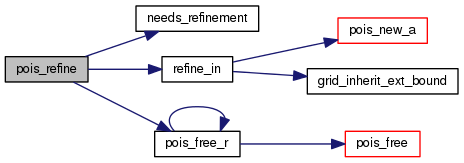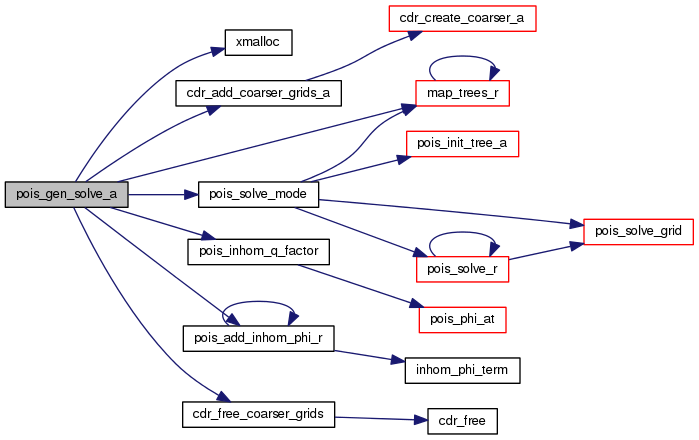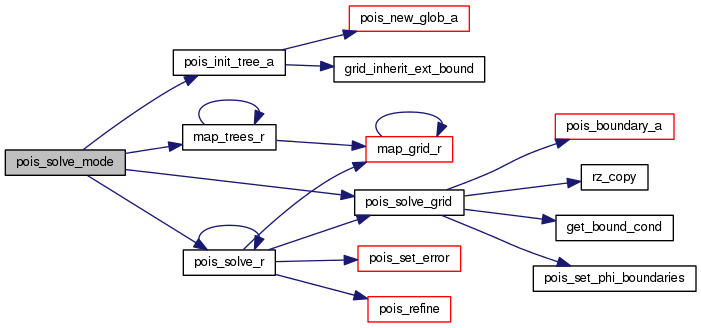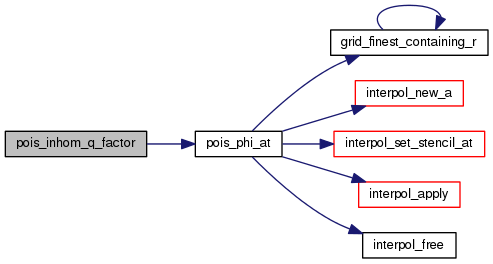|
Streamer fluid modeling - An overview of ARCoS
1.0
|
|
Streamer fluid modeling - An overview of ARCoS
1.0
|
Poisson/Helmholtz solver, including the routines for inhomogeneous (point-plane) configurations. More...
#include <stdlib.h>#include <stdio.h>#include <math.h>#include "cdr.h"#include "cstream.h"#include "fishpack.h"#include "grid.h"#include "interpol2.h"#include "mapper.h"#include "parameters.h"#include "poisson.h"#include "proto.h"#include "rz_array.h"#include "species.h"
Go to the source code of this file.
Macros | |
| #define | REFINE_IN_MAX_WARN_CNT 20; |
| #define | POIS_SOLVE_R_MAX_WARN 50 |
| #define | sum_reflections(total_, field_, r_, z_) |
Functions | |
| static void | get_bound_cond (pois_grid_t *grid, pois_problem_t *prob, int *r_bound_cond, int *z_bound_cond, double lambda) |
| Gets the boundary conditions that we pass to FISHPACK. | |
| static int | needs_refinement (pois_grid_t *grid, int ir, int iz, double threshold) |
| Returns 1 if the given cell has to be refined. | |
| static int | refine_in (pois_grid_t *grid, int cr0, int cz0, int cr1, int cz1) |
| Refines and creates a new grid according to the coordinates given. | |
| decl_mapper_funcs (er) | |
| decl_mapper_funcs (ez) | |
| decl_mapper_funcs (etheta) | |
| decl_mapper_funcs (charge) | |
| static double | inhom_phi_term (double r, double z, double b) |
| static double | inhom_e_term (double r, double z, double b) |
| Common decay factor for the electric fields. | |
| static double | inhom_er_term (double r, double z, double b) |
| Single term of E_r. | |
| static double | inhom_ez_term (double r, double z, double b) |
| Single term of E_z. | |
| void | pois_init (void) |
| All initialization of the Poisson solver has to be here. | |
| pois_grid_t * | pois_new_a (int r0, int z0, int r1, int z1) |
| Creates a 2D Poisson grid. | |
| pois_grid_t * | pois_new_3d_a (int r0, int z0, int r1, int z1, int ntheta) |
| Creates a new 3D Poisson grid. | |
| void | pois_free (pois_grid_t *grid) |
| Frees the memory allocated by pois_new_a. | |
| void | pois_free_r (pois_grid_t *grid) |
| Recursively frees a tree of Poisson grids. | |
| pois_grid_t * | pois_new_glob_a (int r0, int z0, int r1, int z1, int level) |
| Creates a new Poisson grid. | |
| pois_grid_t * | pois_init_tree_a (int r0, int z0, int r1, int z1) |
| Starts the tree of Poisson grids with the two coarsest ones. | |
| REAL * | pois_boundary_a (pois_grid_t *grid, int boundary) |
| Is it possible to use a single function to handle all four boundaries? | |
| void | pois_solve_grid (pois_grid_t *grid, pois_problem_t *prob, double lambda, double s) |
| Solves the Poisson equation, calling the FISHPACK routine. | |
| void | pois_set_phi_boundaries (pois_grid_t *grid, REAL *boundaries[], int left_neu, int right_neu, int bottom_neu, int top_neu) |
| Uses the boundaries[] vectors to set the boundaries by interpolation for the phi array of a grid. | |
| void | pois_set_error (pois_grid_t *grid) |
| Estimates the error on this grid by comparing with the calculations for his parent and performing a Richardson extrapolation. | |
| int | pois_refine (pois_grid_t *grid, double threshold) |
| The refinement routine. | |
| void | pois_error_measures (pois_grid_t *grid, double *L1, double *L2, double *Lmax) |
| Calculates the error measure of this grid. | |
| void | pois_write_error_r (pois_grid_t *grid, FILE *fp) |
| Writes some error measures of this grid and its descendants into fp. | |
| pois_grid_t ** | pois_solve_a (cdr_grid_t *cdr, pois_problem_t *prob) |
| Takes a cdr tree and solves the Poisson equation for it. | |
| pois_grid_t ** | pois_gen_solve_a (cdr_grid_t *cdr, pois_problem_t *prob, mapper_t **mappers, double es) |
| Solves a Poisson/Helmholtz equation with FISHPACK and maps the result using a given set of mapper. | |
| pois_grid_t * | pois_solve_mode (cdr_grid_t *tree, cdr_grid_t *cdr, pois_problem_t *prob, int mode, double es) |
| Solves a single Fourier mode. | |
| void | pois_solve_r (pois_grid_t *pois, cdr_grid_t *cdr, pois_problem_t *prob, int mode, double es, double threshold) |
| Recursively solves one Poisson grid. | |
| void | pois_inhom_init (void) |
| pois_inhom_init QQQQ | |
| double | pois_inhom_phi (double r, double z) |
| Returns the potential created by a unit charge located at pois_inhom_z between an electrode at 0 and a second one at pois_inhom_L. | |
| double | pois_inhom_er (double r, double z) |
| Radial component of the field. | |
| double | pois_inhom_ez (double r, double z) |
| Axial component of the field. | |
| double | pois_inhom_q_factor (pois_grid_t *pois) |
| Once we have the electrostatic potential created by the space charges, we use this function to compute the multiplying factor of the floating charge. | |
| void | pois_add_inhom_phi_r (pois_grid_t *grid, double q) |
| Adds the potential created by the needle to a Poisson grid and their descendants. | |
| void | er_copy (mapper_t *mapper, grid_t *source, grid_t *target, int ir, int iz, int itheta) |
| er_copy QQQQ | |
| void | ez_copy (mapper_t *mapper, grid_t *source, grid_t *target, int ir, int iz, int itheta) |
| ez_copy QQQQ | |
| void | etheta_copy (mapper_t *mapper, grid_t *source, grid_t *target, int ir, int iz, int itheta) |
| etheta_copy QQQQ | |
| void | er_coarsen (mapper_t *mapper, grid_t *source, grid_t *target, int ir, int iz, int itheta) |
| er_coarsen QQQQ | |
| void | ez_coarsen (mapper_t *mapper, grid_t *source, grid_t *target, int ir, int iz, int itheta) |
| ez_coarsen QQQQ | |
| void | etheta_coarsen (mapper_t *mapper, grid_t *source, grid_t *target, int ir, int iz, int itheta) |
| etheta_coarsen QQQQ | |
| int | er_interpol_set (mapper_t *mapper, grid_t *source, interpol_t *interpol, int pr, int pz, int itheta) |
| er_interpol QQQQ | |
| int | ez_interpol_set (mapper_t *mapper, grid_t *source, interpol_t *interpol, int pr, int pz, int itheta) |
| ez_interpol_set QQQQ | |
| int | etheta_interpol_set (mapper_t *mapper, grid_t *source, interpol_t *interpol, int pr, int pz, int itheta) |
| etheta_interpol_set QQQQ | |
| void | er_interpol (mapper_t *mapper, grid_t *source, grid_t *target, interpol_t *interpol, int ir, int iz, int itheta) |
| er_interpol QQQQ | |
| void | ez_interpol (mapper_t *mapper, grid_t *source, grid_t *target, interpol_t *interpol, int ir, int iz, int itheta) |
| ez_interpol QQQQ | |
| void | etheta_interpol (mapper_t *mapper, grid_t *source, grid_t *target, interpol_t *interpol, int ir, int iz, int itheta) |
| etheta_interpol QQQQ | |
| void | charge_copy (mapper_t *mapper, grid_t *source, grid_t *target, int ir, int iz, int itheta) |
| Mapping of the charge. | |
| int | charge_interpol_set (mapper_t *mapper, grid_t *source, interpol_t *interpol, int pr, int pz, int itheta) |
| charge_interpol_set QQQQ. | |
| void | charge_interpol (mapper_t *mapper, grid_t *source, grid_t *target, interpol_t *interpol, int ir, int iz, int itheta) |
| charge_interpol QQQQ. | |
| double | pois_phi_at (pois_grid_t *grid, double r, double z, double theta) |
| Finds the best-possible approximation for the potential at a given point (r, z, theta) by interpolating from the finest grid that covers that point. | |
| void | pois_dump (pois_grid_t *grid, const char *prefix, const char *name) |
| Dumps all the contents of the given grid into filenames given by prefix and name. | |
| void | pois_dump_r (pois_grid_t *grid, const char *prefix, const char *name) |
| Dumps all the contents of the given grid into filenames given by prefix and name. | |
Variables | |
| int | pois_gridpoints_z |
| int | pois_gridpoints_r |
| double | pois_inhom_L |
| double | pois_inhom_z |
| double | pois_inhom_dphi |
| double | pois_inhom_fixed_q_t |
| double | E_x |
| double | E_y |
| double | E_z |
| mapper_t | er_mapper = mk_mapper_staggered (er, &interpol_bilin, 0, -1) |
| mapper_t | ez_mapper = mk_mapper_staggered (ez, &interpol_bilin, -1, 0) |
| mapper_t | etheta_mapper = mk_mapper (etheta, &interpol_quadratic) |
| mapper_t * | e_mappers [] = {&er_mapper, &ez_mapper, ðeta_mapper, NULL} |
| mapper_t | charge_mapper = mk_mapper_down(charge, &interpol_wackers) |
| mapper_t * | charge_mappers [] = {&charge_mapper, NULL} |
| pois_problem_t * | pois_electrostatic |
Poisson/Helmholtz solver, including the routines for inhomogeneous (point-plane) configurations.
Definition in file poisson.c.
| #define sum_reflections | ( | total_, | |
| field_, | |||
| r_, | |||
| z_ | |||
| ) |
|
static |
Gets the boundary conditions that we pass to FISHPACK.
Note that we use the same conditions for the Poisson equation and for the Helmholtz equation used to find the photoionization source. From my point of view, it doesn't make sense to use different conditions, so that will simply add an unneccesary complication.
Definition at line 412 of file poisson.c.

|
static |
Returns 1 if the given cell has to be refined.
which means that it satisfies at least one of the following: a. The error in the cell is larger than the threshold. b. The cell has a neightbour with an error larger than the threshold
Definition at line 909 of file poisson.c.

|
static |
Refines and creates a new grid according to the coordinates given.
(if the FISHPACK limit allows it). Returns TRUE if the refinement succeeded, FALSE otherwise (if the FISHPACK limit was exceeded).
Definition at line 676 of file poisson.c.


| decl_mapper_funcs | ( | er | ) |
| decl_mapper_funcs | ( | ez | ) |
| decl_mapper_funcs | ( | etheta | ) |
| decl_mapper_funcs | ( | charge | ) |
Here we set three mapper_t objects that specify how we should do the mapping between the potential (once it is calculated) and the three components of the electric field.
|
static |
|
static |
|
static |
|
static |
Single term of E_z.
To calculate the potential and electric fields created by a unit charge between two planar electrodes, we use the "mirror charges method" the contribution of each mirror charge is given by these functions.
Definition at line 993 of file poisson.c.


| void pois_init | ( | void | ) |
| pois_grid_t* pois_new_a | ( | int | r0, |
| int | z0, | ||
| int | r1, | ||
| int | z1 | ||
| ) |
| pois_grid_t* pois_new_3d_a | ( | int | r0, |
| int | z0, | ||
| int | r1, | ||
| int | z1, | ||
| int | ntheta | ||
| ) |
| void pois_free | ( | pois_grid_t * | grid | ) |
| void pois_free_r | ( | pois_grid_t * | grid | ) |
| pois_grid_t* pois_new_glob_a | ( | int | r0, |
| int | z0, | ||
| int | r1, | ||
| int | z1, | ||
| int | level | ||
| ) |
| pois_grid_t* pois_init_tree_a | ( | int | r0, |
| int | z0, | ||
| int | r1, | ||
| int | z1 | ||
| ) |
| REAL* pois_boundary_a | ( | pois_grid_t * | grid, |
| int | boundary | ||
| ) |
| void pois_solve_grid | ( | pois_grid_t * | grid, |
| pois_problem_t * | prob, | ||
| double | lambda, | ||
| double | s | ||
| ) |
| void pois_set_phi_boundaries | ( | pois_grid_t * | grid, |
| REAL * | boundaries[], | ||
| int | left_neu, | ||
| int | right_neu, | ||
| int | bottom_neu, | ||
| int | top_neu | ||
| ) |
Uses the boundaries[] vectors to set the boundaries by interpolation for the phi array of a grid.
(in the extra space we allocated when we created the array). xxx_neu tells us if the xxx boundary has Neumann b.c. (or unspecified, as FISHPACK calls them if they are applied in the axis)
TODO: Please rewrite this mess.
Definition at line 465 of file poisson.c.

| void pois_set_error | ( | pois_grid_t * | grid | ) |
| int pois_refine | ( | pois_grid_t * | grid, |
| double | threshold | ||
| ) |
The refinement routine.
Threshold is initially pois_max_error, but if we get too large refinement it can be increased (after warning the user that we are not reaching the accuracy that he asked for).
Definition at line 606 of file poisson.c.


| void pois_error_measures | ( | pois_grid_t * | grid, |
| double * | L1, | ||
| double * | L2, | ||
| double * | Lmax | ||
| ) |
| void pois_write_error_r | ( | pois_grid_t * | grid, |
| FILE * | fp | ||
| ) |
| pois_grid_t** pois_solve_a | ( | cdr_grid_t * | cdr, |
| pois_problem_t * | prob | ||
| ) |
| pois_grid_t** pois_gen_solve_a | ( | cdr_grid_t * | cdr, |
| pois_problem_t * | prob, | ||
| mapper_t ** | mappers, | ||
| double | es | ||
| ) |
Solves a Poisson/Helmholtz equation with FISHPACK and maps the result using a given set of mapper.
From this method downwards (in the sense of calling order, not file organization), all the code is shared by the Poisson solver and the Photoionization (Helmholtz) solver.
Definition at line 777 of file poisson.c.


| pois_grid_t* pois_solve_mode | ( | cdr_grid_t * | tree, |
| cdr_grid_t * | cdr, | ||
| pois_problem_t * | prob, | ||
| int | mode, | ||
| double | es | ||
| ) |
Solves a single Fourier mode.
tree is the root of the cdr tree with extra_pois_levels added. cdr is the cdr grid at level 0, contained in tree:
cdr = tree->first_child->firts_child...->first_child _________ extra_pois_levels __________/
Definition at line 836 of file poisson.c.


| void pois_solve_r | ( | pois_grid_t * | pois, |
| cdr_grid_t * | cdr, | ||
| pois_problem_t * | prob, | ||
| int | mode, | ||
| double | es, | ||
| double | threshold | ||
| ) |
| void pois_inhom_init | ( | void | ) |
| double pois_inhom_phi | ( | double | r, |
| double | z | ||
| ) |
| double pois_inhom_er | ( | double | r, |
| double | z | ||
| ) |
| double pois_inhom_ez | ( | double | r, |
| double | z | ||
| ) |
| double pois_inhom_q_factor | ( | pois_grid_t * | pois | ) |
Once we have the electrostatic potential created by the space charges, we use this function to compute the multiplying factor of the floating charge.
One can also forget about keeping the potential fixed somewhere and impose a constant (non-floating, but may depend on time) charge pois_inhom_fixed_q, which is used if nonzero. The use of that is to simulate a charged cloud close to the earth, which acts as an electrode: usually you would also combine that with the sprite module, that allows varing neutral densities.
Definition at line 1067 of file poisson.c.


| void pois_add_inhom_phi_r | ( | pois_grid_t * | grid, |
| double | q | ||
| ) |
Adds the potential created by the needle to a Poisson grid and their descendants.
Note that  here is in Fourier space and the Laplacian potential is always axi-symmetric, so you only have to call this function with the zero-mode of the Poisson grids.
here is in Fourier space and the Laplacian potential is always axi-symmetric, so you only have to call this function with the zero-mode of the Poisson grids.
The reason that it is better to add the inhomogeneous field to the potential and not later to the electric fields is that if we do that, we will have to substract two large and very curved functions that give something close to zero: the error we make then will be comparable to the result.
Definition at line 1101 of file poisson.c.


| int er_interpol_set | ( | mapper_t * | mapper, |
| grid_t * | source, | ||
| interpol_t * | interpol, | ||
| int | pr, | ||
| int | pz, | ||
| int | itheta | ||
| ) |
| int ez_interpol_set | ( | mapper_t * | mapper, |
| grid_t * | source, | ||
| interpol_t * | interpol, | ||
| int | pr, | ||
| int | pz, | ||
| int | itheta | ||
| ) |
| int etheta_interpol_set | ( | mapper_t * | mapper, |
| grid_t * | source, | ||
| interpol_t * | interpol, | ||
| int | pr, | ||
| int | pz, | ||
| int | itheta | ||
| ) |
| void er_interpol | ( | mapper_t * | mapper, |
| grid_t * | source, | ||
| grid_t * | target, | ||
| interpol_t * | interpol, | ||
| int | ir, | ||
| int | iz, | ||
| int | itheta | ||
| ) |
| void ez_interpol | ( | mapper_t * | mapper, |
| grid_t * | source, | ||
| grid_t * | target, | ||
| interpol_t * | interpol, | ||
| int | ir, | ||
| int | iz, | ||
| int | itheta | ||
| ) |
| void etheta_interpol | ( | mapper_t * | mapper, |
| grid_t * | source, | ||
| grid_t * | target, | ||
| interpol_t * | interpol, | ||
| int | ir, | ||
| int | iz, | ||
| int | itheta | ||
| ) |
| int charge_interpol_set | ( | mapper_t * | mapper, |
| grid_t * | source, | ||
| interpol_t * | interpol, | ||
| int | pr, | ||
| int | pz, | ||
| int | itheta | ||
| ) |
| void charge_interpol | ( | mapper_t * | mapper, |
| grid_t * | source, | ||
| grid_t * | target, | ||
| interpol_t * | interpol, | ||
| int | ir, | ||
| int | iz, | ||
| int | itheta | ||
| ) |
| double pois_phi_at | ( | pois_grid_t * | grid, |
| double | r, | ||
| double | z, | ||
| double | theta | ||
| ) |
| void pois_dump | ( | pois_grid_t * | grid, |
| const char * | prefix, | ||
| const char * | name | ||
| ) |
| void pois_dump_r | ( | pois_grid_t * | grid, |
| const char * | prefix, | ||
| const char * | name | ||
| ) |
| int pois_gridpoints_r |
| double pois_inhom_dphi |
| double pois_inhom_fixed_q_t |
| double E_z |
| mapper_t er_mapper = mk_mapper_staggered (er, &interpol_bilin, 0, -1) |
| mapper_t ez_mapper = mk_mapper_staggered (ez, &interpol_bilin, -1, 0) |
| mapper_t etheta_mapper = mk_mapper (etheta, &interpol_quadratic) |
| mapper_t* e_mappers[] = {&er_mapper, &ez_mapper, ðeta_mapper, NULL} |
| mapper_t charge_mapper = mk_mapper_down(charge, &interpol_wackers) |
| mapper_t* charge_mappers[] = {&charge_mapper, NULL} |
| pois_problem_t* pois_electrostatic |
 1.8.2
1.8.2